September 2023 Regulatory Update
On 14 & 16 August 2023, the CPSC published the final rules 16 CFR 1309 and 16 CFR 1310 for the ban of crib bumpers and inclined sleepers for infants, pursuant to the Safe Sleep for Babies Act of 2021.
The effective dates of these rules were 13 September 2023 and 15 September 2023, respectively.
View Story Read MoreOn 14 & 16 August 2023, two final rules were issued by the CPSC in the United States to codify the ban of crib bumpers and inclined sleepers for infants, pursuant to the Safe Sleep for Babies Act of 2021, H.R. 3182, Public Law 117-126.
Important information related to the two rules is as below.
Ban of Crib Bumpers (16 CFR 1309) Definition of crib bumper per the rule: Crib bumper: (1) Means any material that is intended to cover the sides of a crib to prevent injury to any crib occupant from impacts against the side of a crib or to prevent partial or complete access to any openings in the sides of a crib to prevent a crib occupant from getting any part of the body entrapped in any opening; (2) Includes a padded crib bumper, a supported and unsupported vinyl bumper guard, and vertical crib slat covers; and (3) Does not include a non-padded mesh crib liner.
Banned Hazardous Product: Any crib bumper, regardless of the date of manufacture, is a banned hazardous product under section 8 of the Consumer Product Safety Act.
Effective Date: The effective date of this rule was 13 September 2023.
Ban of Inclined Sleepers for Infants (16 CFR 1310) Definition of inclined sleeper for infants per the rule: Inclined sleeper for infants means a product with an inclined sleep surface greater than ten degrees that is intended, marketed, or designed to provide sleeping accommodations for an infant up to one year old.
Banned Hazardous Product: Any inclined sleeper for infants, regardless of the date of manufacture, is a banned hazardous product under section 8 of the Consumer Product Safety Act.
Effective Date: The effective date of this rule was 15 September 2023.
Please note that the ban of inclined sleepers for infants and crib bumpers has been effective since 12 November 2022 under the Safe Sleep for Babies Act 2021.
On 21 September 2023, the U.S. Consumer Product Safety Commission (CPSC) published a direct final rule for the Safety Standard for Button Cell or Coin Batteries and Consumer Products Containing Such Batteries, codified as 16 CFR 1263. As outlined, all consumer products that contain button cell or coin batteries must comply with ANSI/UL 4200A-2023. Consumer products subject to performance and labeling requirements in this direct final rule must be tested and certified as compliant with the direct final rule.
The direct final rule is effective 23 October 2023, unless the Commission receives a significant adverse comment by 5 October 2023.
On the same day, the Commission also published a final rule separately to establish labeling requirements for button cell or coin battery packaging as these types of products do not fall under scope of UL 4200A-2023.
This rule is effective 21 September 2024. Button cell or coin battery packaging manufactured or imported after 21 September 2024 must comply with this final rule.
View Story Read MoreMandatory Standard for Consumer Products Containing Button Cell or Coin Batteries
On 21 September 2023, the U.S. Consumer Product Safety Commission (CPSC) published a direct final rule for the Safety Standard for Button Cell or Coin Batteries and Consumer Products Containing Such Batteries (16 CFR 1263). One recently substantially revised voluntary standard (ANSI/UL 4200A -2023 Standard for Safety for Products Incorporating Button Batteries or Coin Cell Batteries) was determined by the Commission to meet the Reese's Law's requirements concerning performance and labeling for consumer products with button cell or coin batteries.
According to Reese's Law, any item meant for consumer use that possesses or requires button cell or coin batteries is considered as a "consumer product containing button cell or coin batteries." This definition holds true regardless of whether the batteries are intended for replacement by the consumer, come pre-packaged with the product, or are sold separately. Exempt from this are toys intended for children under the age of 14 that comply with ASTM F963, the Toy Safety Standard, and button cell or coin batteries that the Commission has determined do not present an ingestion hazard (e.g., zinc-air button cell or coin batteries).
The direct final rule is effective 23 October 2023, unless the Commission receives a significant adverse comment by 5 October 2023.
Below are two main categories per the ANSI/UL 4200A-2023 standard:
Performance Evaluation:
Children must not be able to easily access button/coin cells when handling the product.
ANSI/UL 4200A-2023 mandates that the battery compartment be accessible through the use of either a tool like a screwdriver or coin, or through the utilization of at least two separate and simultaneous movements. Consumer products must also undergo a set of performance evaluations that simulate plausible scenarios of both intended and unintended use. The product should be able to undergo mechanical abuse tests without releasing or exposing the batteries.
Labeling:
Furthermore, the standard specifies that consumer products containing button cell or coin batteries must bear appropriate labeling. The labeling is intended to clearly specify the danger of swallowing batteries, advise consumers to keep both new and used batteries out of children's reach, and to immediately seek medical attention if a battery is ingested.
Requirements for Labeling of Button Cell or Coin Battery Packaging
The Commission has also published a final rule separately to establish labeling requirements for button cell or coin battery packaging, as required by Reese’s law, as these types of products do not fall under scope of UL 4200A-2023.
In general, a warning statement must be easily noticeable and permanently marked on the principal display panel of the packaging of the button cell or coin battery in English with the specified format and font size requirements.
The warning statement required is intended to alert consumers to the danger of swallowing batteries, advise consumers to keep both new and used batteries out of children's reach, to immediately seek medical attention if a battery is ingested, and to provide a hotline for treatment information.
Other safety-related statements included in the requirement advise the consumer to keep the batteries in the original package until ready to use and provide instructions on how to correctly dispose of batteries.
This rule is effective 21 September 2024. Button cell or coin battery packaging manufactured or imported after 21 September 2024 must comply with this final rule.
In the US, when hazards are identified in consumer products, they will be recalled and published in the Consumer Product Safety Commission (CPSC) Recent Recalls on the CPSC website, which is updated daily. The US recalls from 01 August 2023 to 31 August 2023 are summarized below:
View Story Read More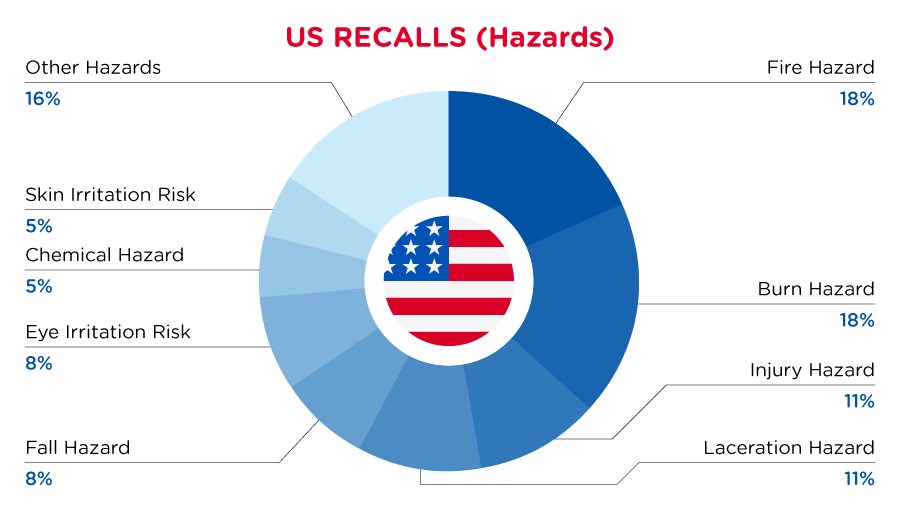
| Hazards | Frequency |
| Fire Hazard | 7 |
| Burn Hazard | 7 |
| Injury Hazard | 4 |
| Laceration Hazard | 4 |
| Fall Hazard | 3 |
| Eye Irritation Risk | 3 |
| Chemical Hazard | 2 |
| Skin Irritation Risk | 2 |
| Other Hazards* | 6 |
*Other Hazards include Risk of Exposure to Combustion Flue Gas, Suffocation Hazard, Choking Hazard, Entrapment Hazard, Explosion Hazard and Strangulation Hazard with a frequency of less than 2.
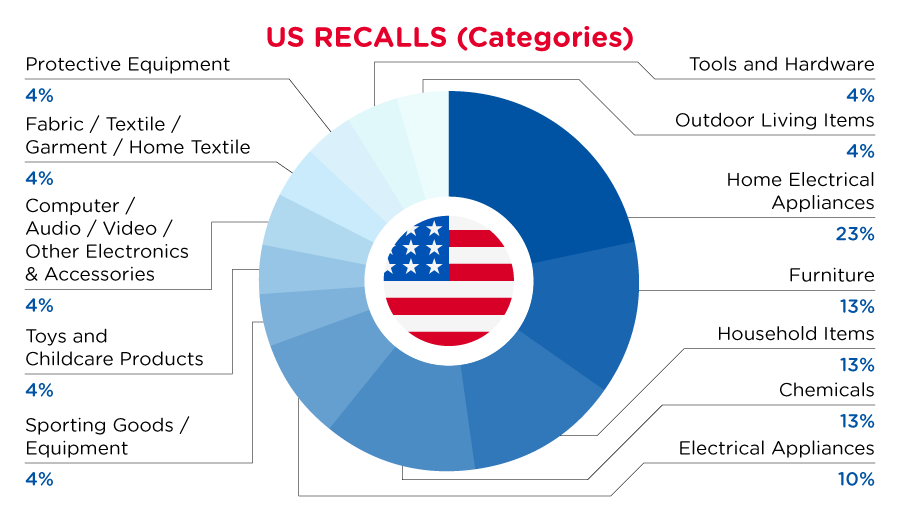
| Product Categories | Frequency |
| Home Electrical Appliances | 5 |
| Furniture | 3 |
| Household Items | 3 |
| Chemicals | 3 |
| Electrical Appliances | 2 |
| Sporting Goods / Equipment | 1 |
| Toys and Childcare Products | 1 |
| Computer / Audio / Video / Other Electronics & Accessories | 1 |
| Fabric / Textile / Garment / Home Textile | 1 |
| Protective Equipment | 1 |
| Tools and Hardware | 1 |
| Outdoor Living Items | 1 |
For a complete list click here
In Canada, when hazards are identified in consumer products, they will be recalled and published in the Recalls and Safety Alerts Database on the Health Canada website, which is updated daily. The Canada recalls from 01 August 2023 to 31 August 2023 are summarized below:
View Story Read More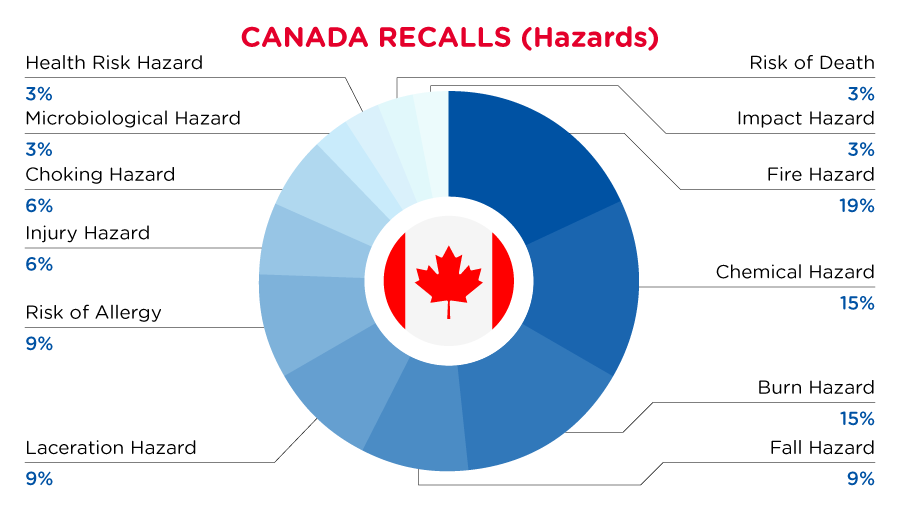
| Hazards | Frequency |
| Fire Hazard | 6 |
| Chemical Hazard | 5 |
| Burn Hazard | 5 |
| Fall Hazard | 3 |
| Laceration hazard | 3 |
| Risk of Allergy | 3 |
| Injury Hazard | 2 |
| Choking Hazard | 2 |
| Microbiological Hazard | 1 |
| Health Risk Hazard | 1 |
| Risk of Death | 1 |
| Impact Hazard | 1 |
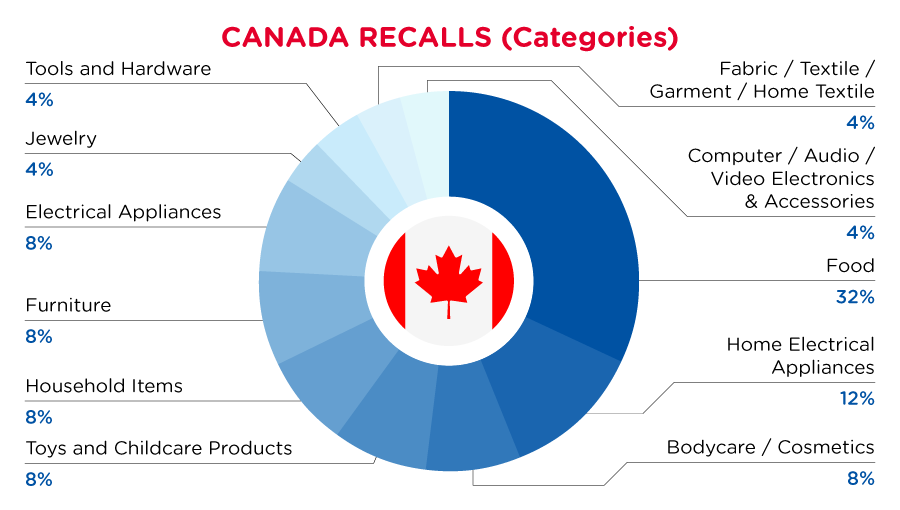
| Product Categories | Frequency |
| Food | 8 |
| Home Electrical Appliances | 3 |
| Bodycare / Cosmetics | 2 |
| Toys and Childcare Products | 2 |
| Household Items | 2 |
| Furniture | 2 |
| Electrical Appliances | 2 |
| Jewelry | 1 |
| Tools and Hardware | 1 |
| Fabric / Textile / Garment / Home Textile | 1 |
| Computer / Audio / Video / Other Electronics & Accessories | 1 |
For a complete list click here
In Australia, when hazards are identified in consumer products, they will be recalled and published in the Recalls and Safety Alerts Database on the Australian Competition & Consumer Commission website, which is updated daily. The Australia recalls from 01 August 2023 to 31 August 2023 are summarized below:
View Story Read More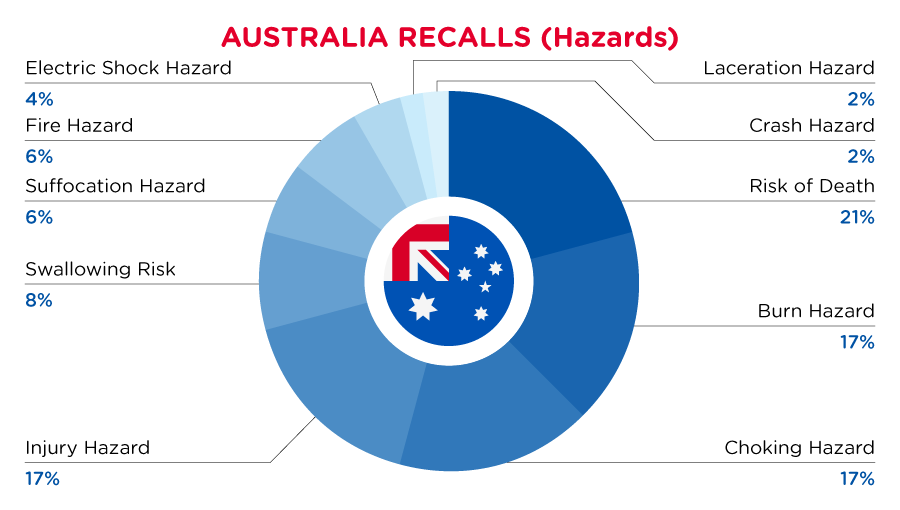
| Hazards | Frequency |
| Risk of Death | 10 |
| Burn Hazard | 8 |
| Choking Hazard | 8 |
| Injury Hazard | 8 |
| Swallowing Risk | 4 |
| Suffocation Hazard | 3 |
| Fire Hazard | 3 |
| Electric Shock Hazard | 2 |
| Laceration Hazard | 1 |
| Crash Hazard | 1 |
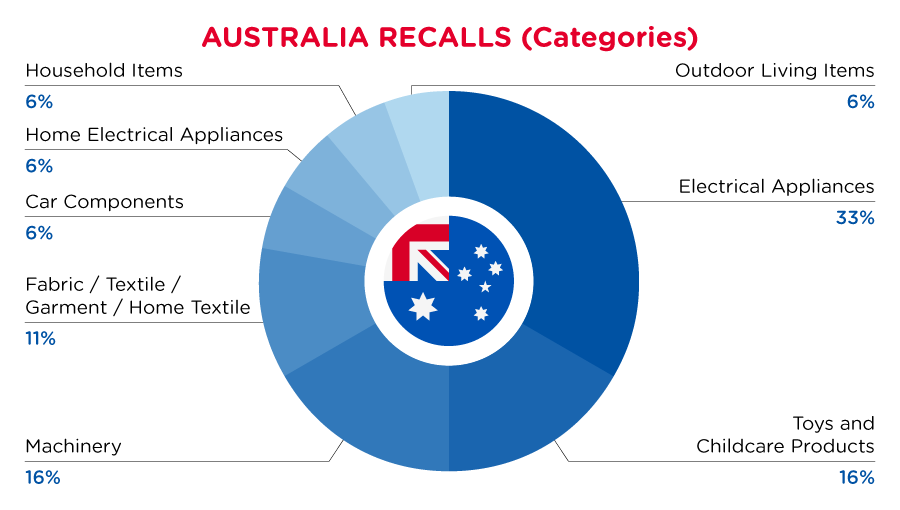
| Product Categories | Frequency |
| Electrical Appliances | 6 |
| Toys and Childcare Products | 3 |
| Machinery | 3 |
| Fabric / Textile / Garment / Home Textile | 2 |
| Car Components | 1 |
| Home Electrical Appliances | 1 |
| Household Items | 1 |
| Outdoor Living Items | 1 |
For a complete list click here
On 1 August 2023, the Department for Business and Trade of the UK has announced the intention to indefinitely extend the use of the CE marking for businesses beyond the upcoming December 2024 deadline for 18 regulations.
View Story Read MoreOn 1 August 2023, the United Kingdom (UK) government announced the extended recognition of the CE marking for placing a wide range of goods on the market in Great Britain, indefinitely, beyond the upcoming December 2024 deadline.
These updates apply to the 18 regulations that fall under the Department for Business and Trade, as listed below:
- Toys
- Pyrotechnics
- Recreational Craft and Personal Watercraft
- Simple Pressure Vessels
- Electromagnetic Compatibility
- Non-automatic Weighing Instruments
- Measuring Instruments
- Measuring Container Bottles
- Lifts
- Equipment for Potentially Explosive Atmospheres (ATEX)
- Radio Equipment
- Pressure Equipment
- Personal Protective Equipment (PPE)
- Gas Appliances
- Machinery
- Equipment for Use Outdoors
- Aerosols
- Low Voltage Electrical Equipment
On 11 August 2023, a new Regulation (EU) 2023/1627 amending Annex I to Food Contact Plastic Regulation (EU) No 10/2011 was published by the European Union.
View Story Read MoreOn 11 August 2023, the European Union published the 17th amendment (Regulation (EU) 2023/1627 ) to Food Contact Plastic Regulation (EU) No 10/2011. This new amendment adds a substance (bis(2-ethylhexyl) cyclohexane-1,4- dicarboxylate (DEHCH)) as an authorized substance which can be intentionally used as an additive in poly(vinyl chloride) (PVC) at up to 25 % w/w in contact at room temperature or below with foods for which food simulants A (10% Ethanol) or B (3% acetic acid) are assigned in Table 2 of Annex III.
The 17th amendment entered into force on 31 August 2023.
The persistent organic pollutant (POP) Recast Regulation of the European Union now includes PFHxS, as well as its salts and PFHxS-related compounds. This new amendment took effect on 28 August 2023.
View Story Read MoreOn 8 August 2023, the European Union (EU) introduced Regulation (EU) 2023/1608, which amends Part A of Annex I in Regulation (EU) 2019/1021 on persistent organic pollutants (POP Recast Regulation, consolidated version as of June 2023). This amendment includes perfluorohexane sulfonic acid (PFHxS), its salts, and PFHxS-related compounds, with some exceptions for intermediate usage or other requirements.
The below table provides a summary of the amendment in significant aspects.
| Substances | Scope | Requirement |
| PFHxS and its salts | Substances, mixtures or articles | ≤ 0.025 mg/kg |
| PFHxS-related Compounds | ≤ 1 mg/kg (Sum of all PFHxS-related compounds) |
|
| PFHxS, its salts and PFHxS-related compounds | Concentrated firefighting foam mixtures that are to be used or are used in the manufacture of other firefighting foam mixtures | ≤ 0.1 mg/kg (This requirement will be reviewed and assessed by the Commission no later than 28 August 2026 relative to potentially strengthening the limit) |
Note:
"Perfluorohexane sulfonic acid (PFHxS), its salts and PFHxS-related compounds" means:
- Perfluorohexane sulfonic acid, including any of its branched isomers
- Its salts
- PFHxS-related compounds which, for the purposes of the Convention, are any substance that contains the chemical moiety C6F13S- as one of its structural elements and that degrades to PFHxS
The effective date for Regulation (EU) 2023/1608 was 28 August 2023.
A draft regulation to replace the current European Union (EU) Toy Safety Directive 2009/48/EC has been published by the EU Commission. The draft is currently open for comments and will undergo further discussion in the EU Council and Parliament.
View Story Read MoreOn 28 July 2023, the European Commission released a proposed draft for the new EU Toy Regulation as a replacement to the current EU Toy Safety Directive 2009/48/EC.
The proposal aims to enhance toy safety and is titled as "Proposal for a Regulation of the European Parliament and of the Council on the safety of toys and repealing Directive 2009/48/EC".
Feedback can now be submitted for this draft until 31 October 2023, through the website titled as “Protecting children from hazardous toys and bolstering the Single Market – revision of the Toy Safety Directive”. All individuals are welcome to share their comments on the draft. After the feedback period, the EU Council and Parliament will engage in further discussion and give their approval.
(The draft may be further amended during the process.)
In comparison with the current EU Toy Safety Directive 2009/48/EC, major changes on this drafted document are summarized as below.
- 1) The requirements will now be outlined in a Regulation, meaning that there is no longer a need for EU member states to convert the requirements into their own local legislation.
- 2) The notion of a "Digital Product Passport" entails crucial details pertaining to item compliance, like the ones present in the Declaration of Conformity. This "passport" shall replace the Declaration of Conformity. To ensure its accessibility, it will be available through a data source, ideally situated on the toy or a label secured onto the toy. For small toys, it may be visible on the product packaging. The Digital Product Passport is already recommended in the Ecodesign Regulation, which lays out standards for sustainability allegations. Nonetheless, this is the first instance that the concept is being introduced for toys, to cover safety and conformity information. The EU Commission will establish a centralized database where passport information is preserved.
- 3) Toys should not only be safe for physical health but also for psychological well-being and cognitive development of children, as they can pose mental health risks.
- 4) More stringent chemical requirements are proposed as below.
- - Proposing limited exemptions, the current broad ban on carcinogenic, mutagenic and reprotoxic chemicals (CMRs) should be extended to encompass other detrimental substances classified as endocrine disruptors, respiratory sensitizers, or toxins for specific organs.
- - The Regulation will permit alterations to the limit values of chemical substances, which can be relevant for all types of toys, rather than only those designed for children under 36 months, as stipulated by the current directive.
- - The limit values for nitrosamines and nitrosatable substances are further lowered.
- - A chemical safety assessment is required to evaluate supplementary risks resulting from the collective exposure to various chemicals found in a toy.
- 5) It will be possible to substitute a written warning with a pictogram, eliminating the need for translation into various EU languages.
- 6) Manufacturers shall collect and analyze consumer complaints.
- 7) Toys placed on the market in conformity with Directive 2009/48/EC before the first day of the month following 30 months after the date of entry into force of this Regulation may continue to be made available on the market until the first day of the month following 42 months after the date of entry into force of this Regulation (grace period).
Those who manufacture and supply toys in the EU will want to pay close attention to any changes in the toy safety regulation to adjust their practices, as needed, to ensure their products will be compliant.
Regulation (EU) 2023/1542, issued by the European Parliament and the Council on 12 July 2023, addresses the topic of batteries and waste batteries. This regulation amends Directive 2008/98/EC and Regulation (EU) 2019/1020 while repealing Directive 2006/66/EC.
View Story Read MoreOn 12 July 2023, the Act concerning batteries and waste batteries, (EU) 2023/1542 was signed by co-legislators and published in the Official Journal on 28 July 2023. The regulation will contribute to environmental protection and resource efficiency and amends Directive 2008/98/EC (on waste) and Regulation (EU) 2019/1020 (on market surveillance and compliance of products) and repeals Directive 2006/66/EC (on batteries and accumulators).
Here are some key points from the newly published legislation:
- Extended Scope and Categories: The regulation extends the scope of batteries and introduces five categories: portable batteries, light means of transport (LMT) batteries, starting, lighting, and ignition (SLI) batteries, industrial batteries, and electric vehicle batteries.
- Restrictions on Hazardous Substances: The regulation continues to restrict the use of mercury and cadmium in batteries. It also introduces a restriction for lead in portable batteries, with specific weight limits for each substance.
- Carbon Footprint Declaration: Electric vehicle batteries, LMT batteries, and certain rechargeable industrial batteries are required to provide a carbon footprint declaration. The information requirements for the declaration will become stricter over time.
- Documentation of Recycled Content: Certain industrial batteries, electric vehicle batteries, LMT batteries, and SLI batteries containing cobalt, lead, lithium, or nickel require documentation on the percentage of these metals that have been recovered through recycling.
- Performance and Durability Requirements: Batteries of general use, excluding button cells, rechargeable industrial batteries, LMT batteries, and electric vehicle batteries, must meet minimum values for electrochemical performance and durability parameters.
- Removability and Replaceability: Portable batteries and LMT batteries must be readily removable and replaceable.
- Safety Requirements for Stationary Battery Energy Storage Systems: Stationary battery energy storage systems must meet safety requirements, and documentation should provide proof of compliance.
- Labelling and Marking: Batteries are required to bear labels containing general information, and from a certain date, they must also be marked with a QR code. Additionally, LMT batteries, industrial batteries with a capacity greater than 2 kWh, and electric vehicle batteries must have an electronic record or "battery passport."
- Battery Management System: Information on the state of health and expected lifetime of stationary battery energy storage systems, LMT batteries, and electric vehicle batteries must be present in the battery management system.
- CE Marking: Batteries need to carry the CE marking, and the conformity assessment procedure and obligations of economic operators are regulated in detail.
- Battery Registration and Collection Targets: Producers are required to register batteries, and mandatory collection targets for portable batteries and LMT batteries will be gradually increased. The regulation also introduces collection targets for certain raw materials in batteries.
Regulation (EU) 2023/1545 was published by the European Union (EU) Commission on 26 July 2023, which modifies Annex III of the Cosmetics Regulation (EC) 1223/2009. This amendment pertains to the mandatory individual labeling requirements of fragrance allergens in cosmetic products by introducing new substances and updating limitations on specific fragrance allergens that are already listed.
View Story Read MoreAnnex III to the Cosmetics Regulation (EC) 1223/2009 has been amended by the EU Commission through the publication of Regulation (EU) 2023/1545 on 26 July 2023. The purpose of this update is to enhance the individual labeling requirements of fragrance allergens in cosmetic products by including new substances and revising restrictions for existing fragrance allergens.
In the past, EU Cosmetics Regulation 1223/2009 mandated the disclosure of 24 fragrance allergens on the list of ingredients of a cosmetic product, which required individual labeling. After the Commission's call for an updated list of individually labeled fragrance allergens, the Scientific Committee on Consumer Safety (SCCS) conducted a thorough examination. On 15 September 2022, the EU introduced 56 newly discovered fragrance allergens in cosmetics through a draft Commission Regulation that was notified to the WTO. The SCCS provided its opinion (SCCS/1459/11) on the draft regulation. On 26 July 2023, the Commission released a new amendment to the Cosmetic Regulation, which included 45 new entries, revised 17 existing entries, and removed 10 entries from the Annex.
In total, 80 allergenic components and component groups are now identified and must be labeled on cosmetic items. These ingredients, whether synthetic fragrances or natural essential oils, must be listed on the product packaging or container, along with the terms "parfum" or "aroma," depending on their concentration levels, such as:
- - at least 0.01% in rinse-off cosmetics (e.g., soap, shower gel, shampoo)
- - at least 0.001% in leave-on cosmetics (e.g., cream, lotion, tonic)
Furthermore, amendments were made to 17 entries in line with the latest version of the Common Ingredients Glossary, adding isomers, and revising the respective Chemical Abstracts Service (CAS) and EC numbers.
Economic operators are required to adjust product formulations and containers to comply with the new rules and guarantee that only cosmetics adhering to the updated requirements are available on the market. Starting from 16 August 2023, Regulation (EU) 2023/1545 became effective and shall be uniformly applied across all Member States. Adjustments to product formulations, containers, product withdrawals, and new labeling may entail significant changes. Therefore, the compliance transition period for new products expires on 31 July 2026, whereas for existing products, it terminates on 31 July 2028.
In Europe, when hazards are identified in non-food consumer products, the products will be recalled and published in the Safety Gate system, which is updated weekly. The European recalls from 01 August 2023 to 31 August 2023 are summarized below:
View Story Read More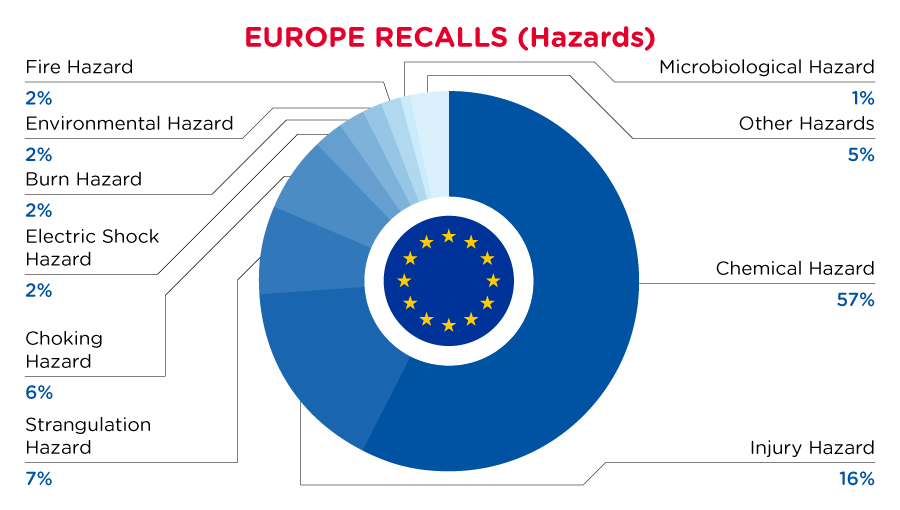
| Hazards | Frequency |
| Chemical Hazard | 185 |
| Injury Hazard | 53 |
| Strangulation Hazard | 24 |
| Choking Hazard | 20 |
| Electric Shock Hazard | 8 |
| Burn Hazard | 7 |
| Environmental Hazard | 6 |
| Fire Hazard | 5 |
| Microbiological Hazard | 3 |
| Other Hazards* | 10 |
*Other Hazards include Damage to Sight, Health Risk Hazard, Suffocation Hazard, Drowning Hazard, Cut Hazard and Damage to Hearing with a frequency of less than 3.
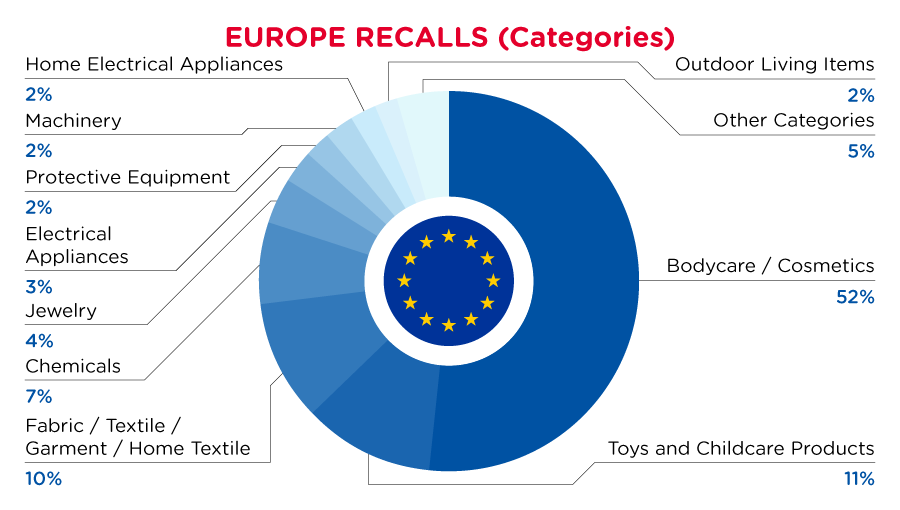
| Product Categories | Frequency |
| Bodycare / Cosmetics | 148 |
| Toys and Childcare Products | 32 |
| Fabric / Textile / Garment / Home Textile | 29 |
| Chemicals | 20 |
| Jewelry | 11 |
| Electrical Appliances | 8 |
| Protective Equipment | 7 |
| Machinery | 7 |
| Home Electrical Appliances | 6 |
| Outdoor Living Items | 6 |
| Other Categories* | 12 |
*Other Categories include Sporting Goods / Equipment, Computer / Audio / Video / Other Electronics & Accessories, Footwear, Household Items, Accessories, Car Components, Tools and Hardware, Furniture and Stationery with a frequency of less than 6.
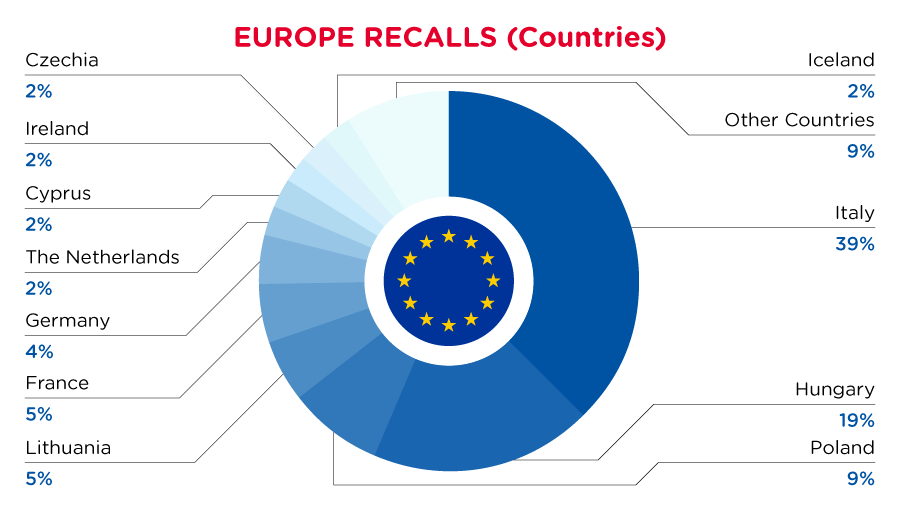
| Notifying Country | Frequency |
| Italy | 108 |
| Hungary | 54 |
| Poland | 23 |
| Lithuania | 15 |
| France | 14 |
| Germany | 12 |
| The Netherlands | 7 |
| Cyprus | 7 |
| Ireland | 7 |
| Czechia | 7 |
| Iceland | 7 |
| Other Countries* | 25 |
*Other Countries include Austria, Bulgaria, Sweden, Finland, Latvia, Portugal, Denmark, Norway and Slovakia with a frequency of less than 7.
For a complete list click here
The China national standard GB/T 8878-2023 "Knitted Underwear" will be implemented on 1 December 2023. The new standard will replace GB/T 8878-2014 "Cotton Knitted Underwear". The name was changed and the scope of application was expanded.
View Story Read MoreThe China national standard for Knitted Underwear, GB/T 8878-2023, will replace GB/T 8878-2014 for Cotton Knitted Underwear. The scope of the application was expanded as outlined below and the name of the standard was updated from "Cotton Knitted Underwear" to "Knitted Underwear".
GB/T 8878-2023 Standard Scope:
This standard applies to knit underwear but does not apply to knit underwear for infants over 36 months. It stipulates the size, requirements, testing, sampling rules, judgement rules, product usage instructions, packaging, transportation and storage of knit underwear.
Main Test Contents:
The GB/T 8878-2023 standard includes fiber content, formaldehyde, pH value, AZO dye, odor, bursting pilling resistance, dimension stability, color fastness to washing, color fastness to water, color fastness to rubbing, and color fastness to perspiration. Also, there are specifications for appearance after washing. The knit underwear for children aged 3-14 years must also comply with GB 31701 on infants and children’s textile products.
Main Technical Changes in GB/T 8878-2023:
Compared to GB/T 8878-2014, GB/T 8878-2023 has undergone several revisions, including:
Additions:
- Vest measurement position diagram
- Natural color or bleach product no longer needing to be tested for color fastness
- Requirements for grading defects based on appearance of defects using bonding processes
- Label rules for oversize glue systems
- Pilling, appearance after washing test methods
- Refined requirements for pilling and detergent staining
- Requirements for primary and secondary components of clothing, skewness of solid color products, pilling, detergent soiling, post-wash appearance, etc.
Amendments to:
- Scope
- Some requirements for symmetrical parts size deviation tolerance and size difference tolerance
- Requirements for bursting strength and dimension stability
- Dimension stability, chromatism requirements (qualified grade)
- Testing conditions for post-wash dimension change and appearance quality
Deletions:
- Deleted the "sewing requirements"
The implementation date for GB/T 8878-2023 will be 1 December 2023.
In China, when hazards are identified in consumer products, they will be recalled and published in the SAMR Defective Product Administrative Centre, which is updated daily. The China recalls from 01 August 2023 to 31 August 2023 are summarized below:
View Story Read More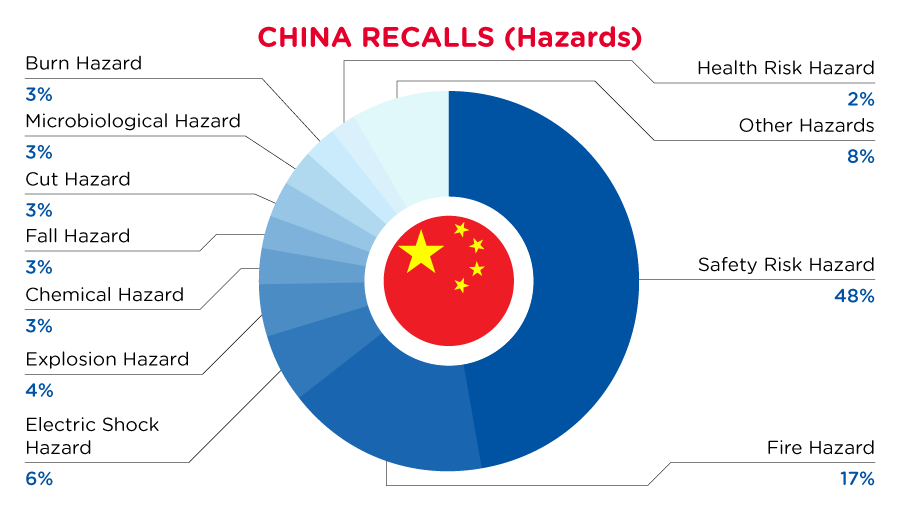
| Hazards | Frequency |
| Safety Risk Hazard | 64 |
| Fire Hazard | 23 |
| Electric Shock Hazard | 8 |
| Explosion Hazard | 6 |
| Chemical Hazard | 4 |
| Fall Hazard | 4 |
| Cut Hazard | 4 |
| Microbiological Hazard | 4 |
| Burn Hazard | 4 |
| Health Risk Hazard | 3 |
| Other Hazards* | 11 |
*Other Hazards include Suffocation Hazard, Entanglement Hazard, Laceration Hazard, Strangulation Hazard, Crushing Hazard, Crash Hazard, Swallowing Risk and Lead Poisoning Hazard with a frequency of less than 3.
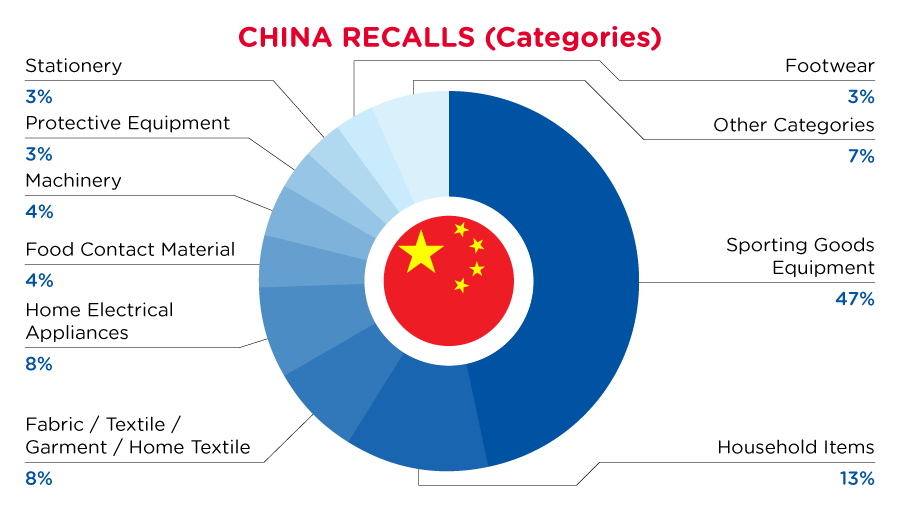
| Product Categories | Frequency |
| Sporting Goods / Equipment | 42 |
| Household Items | 11 |
| Fabric / Textile / Garment / Home Textile | 7 |
| Home Electrical Appliances | 7 |
| Food Contact Material | 4 |
| Machinery | 4 |
| Protective Equipment | 3 |
| Stationery | 3 |
| Footwear | 3 |
| Other Categories* | 6 |
*Other Categories include Toys and Childcare Products, Computer / Audio / Video / Other Electronics & Accessories, Furniture and Chemicals with a frequency of less than 3.
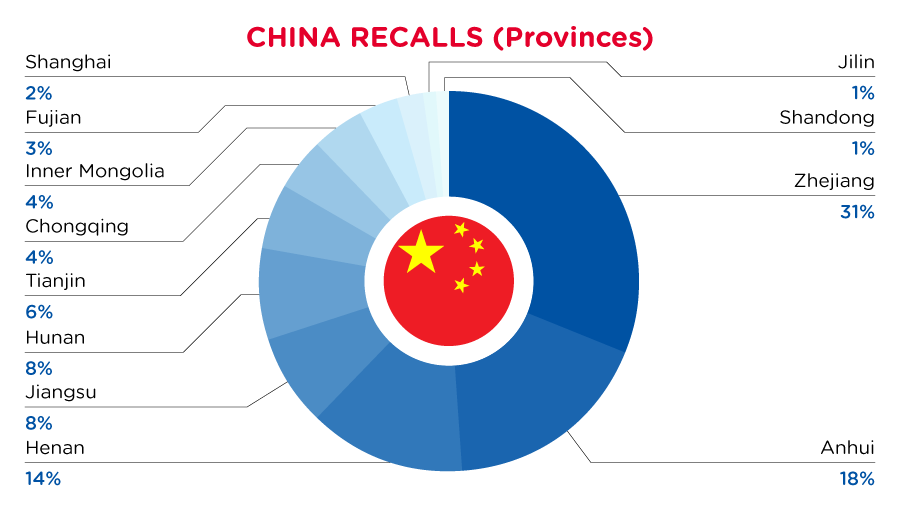
| Provinces | Frequency |
| Zhejiang | 28 |
| Anhui | 16 |
| Henan | 12 |
| Jiangsu | 7 |
| Hunan | 7 |
| Tianjin | 5 |
| Chongqing | 4 |
| Inner Mongolia | 4 |
| Fujian | 3 |
| Shanghai | 2 |
| Jilin | 1 |
| Shandong | 1 |
For a complete list click here

